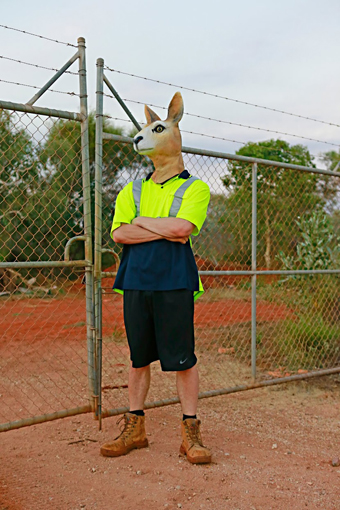Fearful future dreaming
Mari Lourey: Marrugeku, Cut the Sky

Josh Mu, Cut the Sky, Marrugeku
photo Rod Hartvigsen
Josh Mu, Cut the Sky, Marrugeku
In late May. Broome dance theatre company Marrugeku showcased Cut the Sky for an invited community audience as a prelude to a program of national and international touring in 2015. Cut the Sky looks to the future, contemplating global climate change from an Indigenous point of view in a multi-artform work. It has been developed by a team of artists and Indigenous cultural leaders from across the Kimberley and urban Australia collaborating with artists from Burkina Faso, Belgium and Assam in Northern India.
The work is presented in five acts based around five poems by Walmajarri/Nyikina poet and ‘dream catcher’ Edwin Lee Mulligan, with two original songs composed by Papua New Guinean born ‘future soul’ singer/songwriter Ngaiire and extant songs by Nick Cave, among others, all sung by Broome-based actress Ngaire Pigram.
Mulligan’s poems are a standout, capturing what I have observed over the years to be an Indigenous three dimensional grid of knowledge and perspectives that encompasses the heavens, earth and water, and which has existed via traditional stories and lore in this part of the world for over 40,000 years: “…Taking a transformation as an eagle and in that formation I was travelling within the cloud dust…”
To see and hear Mulligan performing his poetry without artifice and with an accent that suggests English may be his second or third language brings an integrity to the work that is in keeping with the authenticity of Marrugeku’s ethos.
Mulligan’s poetry encapsulates a way of being in the world, of “holding it, that may demand a new kind of attention of its audience” as Cut the Sky director Rachael Swain puts it in her essay, “Time and a Mirror: Towards a Hybrid Dramaturgy for Intercultural-Indigenous Performance” in New Dramaturgy, editors Katalin Trencsényi and Bernadette Cochrane, Bloomsbury, 2014.
Marrugeku’s hallmark style of contemporary dance—devised from the performers’ personal and cultural backgrounds—is on full display. In a memorable sequence dancer-choreographer Dalisa Pigram’s portrayal of a drunk FIFO mine worker veered from the comic to the compelling, before morphing into a study of a disturbed psyche in a disturbed land, culminating in a frenzy of ‘digging up’ her own self.
A distillation of the unique perspectives of Kimberley cultural and artistic leaders is the work’s heart and greatest strength. Other contributors to these perspectives include Marrugeku’s patron Patrick Dodson, Bunuba cultural leader June Oscar and Yawuru dancer and language speaker Dalisa Pigram, the company’s co-artistic director. These perspectives are then framed within a multi-art form expression embracing both contemporary video and archival footage—including the famed Noonkambar Station anti-drilling campaign in 1979—original music and sound-scape design, virtuosic contemporary dance and original text.
The sum total is an ambitious and richly imaginative work that eschews didacticism. Instead, it ignites our imaginations by using the transformative power of metaphor to provide a window through which we can glimpse the possibilities of a different way of being, both before and after what would appear to be inevitable climate catastrophe.
–
Cut the Sky, co-created by cast and creative and cultural team; concept Dalisa Pigram, Rachael Swain, director Rachael Swain, co-choreographers Dalisa Pigram, Serge Aimé Coulibaly, storyteller Edwin Mulligan, performer, singer Ngaire Pigram, dancer Miranda Wheen, Dalisa Pigram, Eric Avery, Josh Mu, dramaturg Hildegard de Vuyst, cultural advisor Patrick Dodson, musical director Matthew Fargher, new media artists Desire Machine Collective [Sonal Jain, Mriganka Madhukaillya], costumes, set realisation Stephen Curtis; Broome, May 22, 23
RealTime issue #121 June-July 2014 pg. web






